You searched for: nuremberg
<< Previous | Displaying results 1-50 of 468 for "nuremberg" | Next >>
-
The Nuremberg Courtroom
ArticleThe International Military Tribunal took place in the Palace of Justice at Nuremberg, the only undamaged facility extensive enough to house the trials.
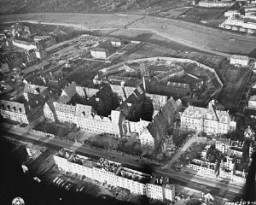
-
Nuremberg Trials
ArticleTrials of top surviving German leaders for Nazi Germany’s crimes began in Nuremberg after World War II. Read about the Nuremberg trials.
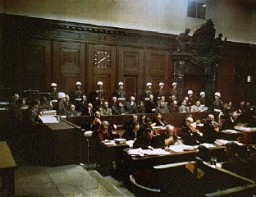
-
The Nuremberg Code
ArticleLeading German physicians and administrators were put on trial for their role during the Holocaust. The resulting Nuremberg Code was a landmark document on medical ethics. Learn more
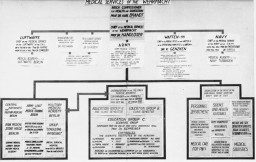
-
The Nuremberg Race Laws
ArticleThe Nazi regime’s Nuremberg Race Laws of September 1935 made Jews legally different from their non-Jewish neighbors. The laws were the foundation for future antisemitic measures .
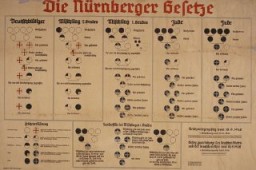
-
Subsequent Nuremberg Proceedings
ArticleAmerican military tribunals presided over 12 Subsequent Nuremberg Proceedings against leading German industrialists, military figures, SS perpetrators, and others.
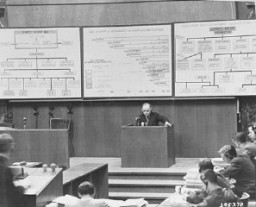
-
International Military Tribunal at Nuremberg
ArticleThe International Military Tribunal (IMT) opened in Nuremberg within months of Germany’s surrender. Learn about the judges, defendants, charges, and legacies.
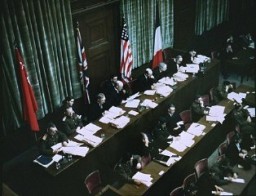
-
Subsequent Nuremberg Proceedings, Case #2: The Milch Case
ArticleThe Milch Case was Case #2 of 12 Subsequent Nuremberg Proceedings against leading German industrialists, military figures, SS perpetrators, and others.
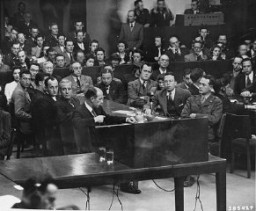
-
Subsequent Nuremberg Proceedings, Case #5: The Flick Case
ArticleThe Flick Case was Case #5 of 12 Subsequent Nuremberg Proceedings against leading German industrialists, military figures, SS perpetrators, and others.
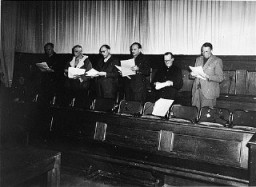
-
Subsequent Nuremberg Proceedings, Case #8, The RuSHA Case
ArticleThe RuSHA Case was Case #8 of 12 Subsequent Nuremberg Proceedings against leading German industrialists, military figures, SS perpetrators, and others.
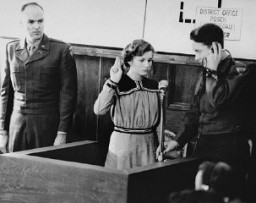
-
Subsequent Nuremberg Proceedings, Case #10: The Krupp Case
ArticleThe Krupp Case was Case #10 of 12 Subsequent Nuremberg Proceedings against leading German industrialists, military figures, SS perpetrators, and others.
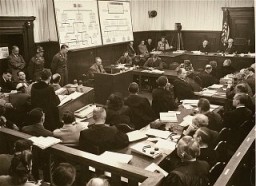
-
Combating Holocaust Denial: Evidence of the Holocaust presented at Nuremberg
ArticleAt the Nuremberg trials, Allied prosecutors submitted documentation left by the Nazi state itself. This evidence is a lasting refutation of attempts to deny the Holocaust.

-
Subsequent Nuremberg Proceedings, Case #4: The Pohl Case
ArticleThe Pohl Case was Case #4 of 12 Subsequent Nuremberg Proceedings against leading German industrialists, military figures, SS perpetrators, and others.
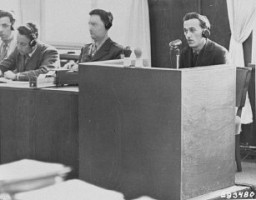
-
Subsequent Nuremberg Proceedings, Case #9, The Einsatzgruppen Case
ArticleThe Einsatzgruppen Case was Case #9 of 12 Subsequent Nuremberg Proceedings against leading German industrialists, military figures, SS perpetrators, and others.
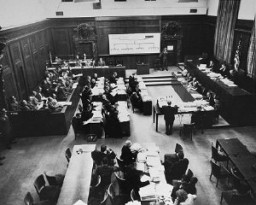
-
The Doctors Trial: The Medical Case of the Subsequent Nuremberg Proceedings
ArticleThe Medical Case, or Doctors Trial, was Case #1 of 12 Subsequent Nuremberg Proceedings against leading German industrialists, military figures, SS perpetrators, and others.
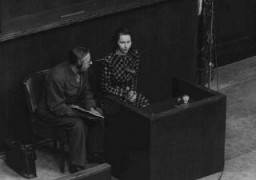
-
Subsequent Nuremberg Proceedings, Case #3: The Justice Case
ArticleThe Justice Case was Case #3 of 12 Subsequent Nuremberg Proceedings against leading German industrialists, military figures, SS perpetrators, and others.
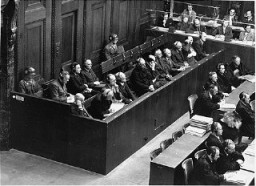
-
Subsequent Nuremberg Proceedings, Case #7, The Hostage Case
ArticleThe Hostage Case was Case #7 of 12 Subsequent Nuremberg Proceedings against leading German industrialists, military figures, SS perpetrators, and others.
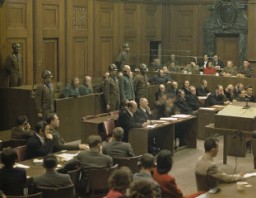
-
Subsequent Nuremberg Proceedings, Case #11: The Ministries Case
ArticleThe Ministries Case was Case #11 of 12 Subsequent Nuremberg Proceedings against leading German industrialists, military figures, SS perpetrators, and others.
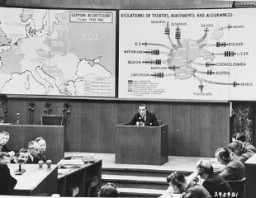
-
Subsequent Nuremberg Proceedings, Case #6, The IG Farben Case
ArticleThe IG Farben Case was Case #6 of 12 Subsequent Nuremberg Proceedings against leading German industrialists, military figures, SS perpetrators, and others.
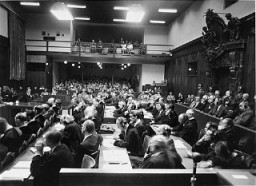
-
Subsequent Nuremberg Proceedings, Case #12: The High Command Case
ArticleThe High Command Case was Case #12 of 12 Subsequent Nuremberg Proceedings against leading German industrialists, military figures, SS perpetrators, and others.
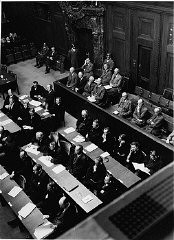
-
Nuremberg Race Laws
ArticleLearn more about the Reich Citizenship Law and the Law for the Protection of German Blood and German Honor, collectively known as the Nuremberg Race Laws.
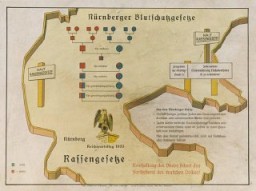
-
Arriving in Nuremberg to testify
PhotoFour Polish women arrive at the Nuremberg train station to serve as prosecution witnesses at the Doctors Trial. From left to right are Jadwiga Dzido, Maria Broel-Plater, Maria Kusmierczuk, and Wladislawa Karolewska. December 15, 1946.
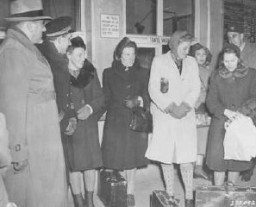
-
US troops in Nuremberg
PhotoThe inhabitants of Nuremberg watch a parade of US troops through their city. Nuremberg, Germany, 1946.
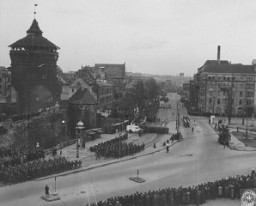
-
Anti-Masonic exhibition in Nuremberg
PhotoA reconstruction of a Masonic lodge from the Isle of Jersey, on display in an anti-Masonic exhibition in Nuremberg. Germany, 1938.
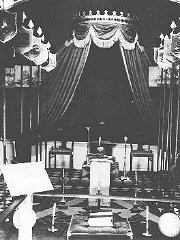
-
War damage in Nuremberg
PhotoAt the time of the International Military Tribunal, the city of Nuremberg reflected the devastation of war, as did much of Europe. This landscape of destruction stands in stark contrast to the Nazi rallies held in Nuremberg only years earlier.
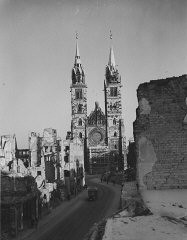
-
Nuremberg decorated with Nazi flags
PhotoView of a bridge spanning a canal in Nuremberg. The houses and bridge are decorated with Nazi flags and banners. Photograph taken by Julien Bryan in Nuremberg, Germany, 1937.
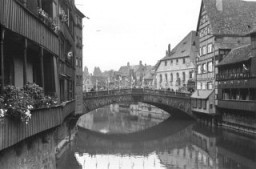
-
Bomb damage in Nuremberg
PhotoView of the bombed-out city of Nuremberg. Visible in the distance is the twin-spired Lorenz Church, and on the right, a statue of Kaiser Wilhelm I. Nuremberg, Germany, 1945.
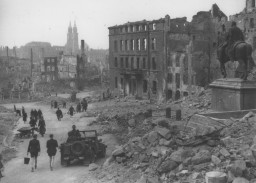
-
Translators at the Nuremberg trial
PhotoEnglish, French, Russian, and German were official languages of the Nuremberg trials. Translators provided simultaneous translations of the proceedings. Here, they route translations through a switchboard to participants in the trial. Nuremberg, Germany, November 1945.
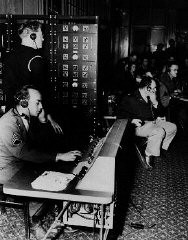
-
The Palace of Justice in Nuremberg
PhotoThe Palace of Justice in Nuremberg, Germany, where the International Military Tribunal trial of war criminals was held. The flags of the four prosecuting countries (French, American, British, and Soviet) hang above the entrance.
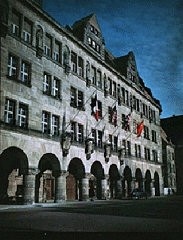
-
Defendants' cell block in Nuremberg
PhotoBirds-eye view of the fenced-in cell block where defendants in the International Military Tribunal war crimes trial were imprisoned. Nuremberg, Germany, between November 20, 1945, and October 1, 1946.
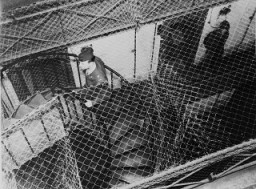
-
War damage in Nuremberg
FilmAt the end of World War II, more than three-quarters of the city of Nuremberg, Germany, lay in rubble. This US Army Air Corps color footage shows some of the war damage in Nuremberg, which had been host in the 1920s and 1930s to massive and lavish rallies for the Nazi party.
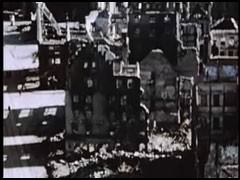
-
Nazi Party rally in Nuremberg
FilmIn the 1920s and 1930s, the German city of Nuremberg was host to massive and lavish rallies for the Nazi Party. This film footage, produced by Julien Bryan in 1937, shows saluting crowds in the Nuremberg stadium watching groups parade past Adolf Hitler.
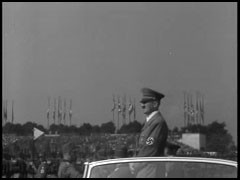
-
View of the Palace of Justice in Nuremberg
PhotoView of the Palace of Justice (left), where the International Military Tribunal trial was held. Nuremberg, Germany, November 17, 1945. The Palace of Justice was selected by the Allied powers as the location for the International Military Tribunal (IMT) because it was the only undamaged facility extensive enough to accommodate a major trial. The site contained 20 courtrooms and a prison capable of holding 1,200 prisoners.
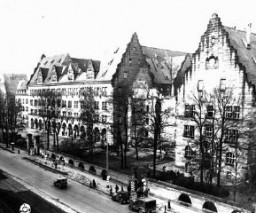
-
Aerial view of the Nuremberg prison
PhotoAn aerial view of the Nuremberg prison, where defendants in the International Military Tribunal war crimes trial were held. Photograph taken in Nuremberg, Germany, between October 1945 and October 1946.
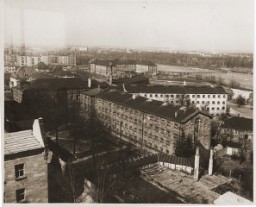
-
Supreme Court Decision on the Nuremberg Race Laws
ArticleLearn more about the 1936 German Supreme Court decision on the Nuremberg Race Laws.

-
Defendant Julius Streicher at Nuremberg
PhotoDefendant Julius Streicher, editor of the racist newspaper Der Stuermer. Streicher was one of the MT brought 24 leading German officials charged by the International Military Tribunal at Nuremberg.
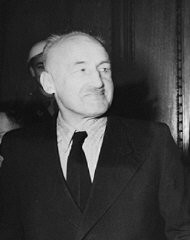
-
Nuremberg Race Laws
Timeline EventSeptember 15, 1935. On this date, the Nazi government passed the Nuremberg Race Laws, making Jews legally different from their non-Jewish neighbors.

-
Albert Speer sworn in at Nuremberg
FilmDefendant Albert Speer is sworn in at the International Military Tribunal.
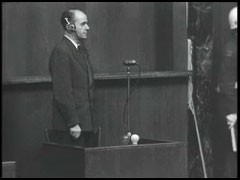
-
Albert Speer testifies at Nuremberg
FilmAlbert Speer gives testimony at the International Military Tribunal. In 1942 Speer was named Minister of Armaments and Munitions, assuming significant responsibility for the German war economy. In this position, Speer used millions of forced laborers to raise economic production.
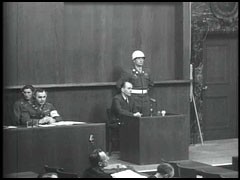
-
Nuremberg Trial: Göring testifies
FilmHermann Göring was head of the German air force. He was one of 22 major war criminals tried by the International Military Tribunal at Nuremberg. Here, Göring testifies about his order of July 31, 1941, authorizing Reinhard Heydrich, head of the Reich Security Main Office, to plan a so-called "solution to the Jewish question in Europe." The Tribunal found Göring guilty on all counts and sentenced him to death. Göring committed suicide shortly before his execution was to take place.
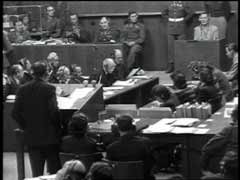
-
Members of the French prosecution team at Nuremberg
PhotoThe French prosecution table at the International Military Tribunal trial of war criminals at Nuremberg.
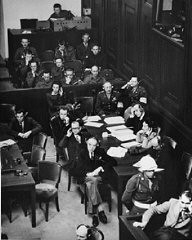
-
View of a criminal wing in the prison at Nuremberg
PhotoView of a criminal wing in the prison at Nuremberg, housing war crimes trials defendants. Baltic guards under the supervision of American authorities patrol the wing and keep constant watch over the prisoners. The upper floors are screened off with heavy chicken wire to discourage suicide attempts. Nuremberg, Germany, between November 20, 1945, and October 1, 1946.
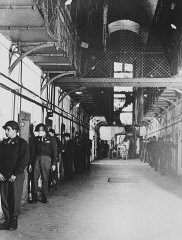
-
Chart with the title "Die Nürnberger Gesetze" [Nuremberg Race Laws]
PhotoChart with the title "Die Nürnberger Gesetze" [Nuremberg Race Laws]. In the fall of 1935, German Jews lost their citizenship according to the definitions posed in these new regulations. Only "full" Germans were entitled to the full protection of the law. This chart was used to aid Germans in understanding the laws. White circles represent "Aryan" Germans, black circles represent Jews, and partially shaded circles represent “mixed raced” individuals. The chart has columns explaining the…
![Chart with the title "Die Nürnberger Gesetze" [Nuremberg Race Laws]](https://encyclopedia.ushmm.org/images/thumb/109130bd-4617-43ad-a556-d2955f1a4aa3.jpg)
-
"We will show you their own films": Film at the Nuremberg Trial
ArticleNazi Germany’s dedicated filming of itself became evidence of its crimes and was displayed at the International Military Tribunal at Nuremberg. Learn more.
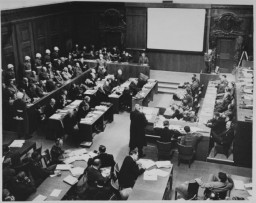
-
Aerial view of the Nuremberg Palace of Justice
PhotoAerial view of the Nuremberg Palace of Justice, where the International Military Tribunal tried 22 leading German officials for war crimes. Nuremberg, Germany, November 1945.

